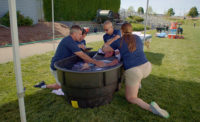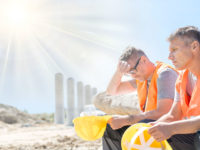Heat safety is on everyone’s minds as much of the country labors under sweltering temperatures. Although summer is in full swing, it’s never too late to adjust your heat safety program, especially if you’re struggling with continued heat illness incidents. Basic heat safety can be broken down into three overarching categories:
- Learning and education
- Gearing up to cool down
- Expecting the unexpected
Learning and education
If you’re experiencing incidents, ask how many of them started with a misunderstanding. If your workers don’t fully understand the risks, signs and symptoms, and actions to take in hot conditions, retraining and regular reminders may go a long way toward solving the problem. Mandatory heat safety classes followed by quizzes to test their knowledge are a good way to educate workers and managers alike about basic heat hygiene. Regular reminders may take the form of prominent heat safety posters, urine color charts in every stall and above every urinal in your restrooms, and reminder videos either looped in break areas or even sent directly to workers’ phones.
Be sure that part of your education process includes information on heat acclimatization. More than 70 percent of heat-related deaths happen during a worker’s first week laboring in hot conditions. Unprepared bodies can fail to sweat adequately to release heat and may even experience higher heart rates that can put workers at risk. It’s just as important to reacclimatize workers if they’ve been on vacation, off due to an injury, or away from working in hot conditions while still on the job. And remember that heat acclimatization does not make workers invincible. Even well-acclimated people can still experience heat illness.
Repeat your heat illness prevention training more often than just at the beginning of the summer or when workers start a new job. Bring people in for a refresher on a regular basis and mix the training up to make sure they’re paying attention. Ask questions at the end or create test scenarios for them to talk through. A complete understanding of heat illness prevention and emergency response can and does save lives.
Gearing up to cool down
Failing to provide the right prevention measures for heat safety can cost you in workplace incidents and OSHA fines, particularly with the OSHA Heat Safety NEP still in force. Be sure you have everything covered:
Hydration — Do you have cool water and electrolyte-replacing beverages available and close to every work area? Cool drinks serve the dual purpose of keeping workers hydrated and helping to lower their body temperature. And while this step is crucial, don’t forget that even a well-hydrated person can experience heat illness if conditions are hot enough and/or the work is hard enough that their body produces more internal heat than it can shed. Hydration is just one tool in the toolbox, not the whole package.
Body-cooling stations — No matter where the job gets done, you need a place where workers can get out of the heat and actively lower their body temperature. That might include air-conditioned breakrooms or trailers, shaded areas with fans and misters, cooling tents, or even cooled bathroom trailers or lunchrooms. Be sure these stations are well-equipped with cool drinks, body cooling PPE, refrigerators or coolers full of ice, and even cotton towels on ice to allow workers to get relief from the heat. If the job requires PPE that can be removed on breaks, be sure to allow enough time for workers to remove their PPE, cool down, and put their PPE back on properly without rushing, to eliminate the temptation to cut corners.
Body-cooling PPE — Cooling breaks are important, but cooling while on the job can keep people safer, more comfortable, and productive too. The new generation of body cooling PPE uses the natural power of evaporation without a chemical coating that can make fabrics stiff as they dry. These items cool down to a refreshing 30 degrees below average body temperature in under 60 seconds and they can be activated again and again with just water, so workers have a way to cool down instantly all through their shift. Some now even come FR-rated for jobs with exposure to sparks and flames. Here too, this PPE is another tool in the toolbox — it doesn’t take the place of proper cooling breaks.
Environmental monitoring — While the weather forecast can tell you what to expect for the day in general, it can’t tell you the specific conditions in various areas of a plant or jobsite. For that, you need a WBGT monitor that can track temperature, humidity, wind speed, and sun exposure in a specific area. Understanding conditions in every part of the job can help you modify work-to-rest ratios and shift times to keep workers safer. Consult with an expert to find a WBGT option you’re comfortable using.
Lighter, cooler PPE — Depending on the hazards in the job, additional PPE and the need to cover large areas of the body are sometimes unavoidable. But that doesn’t necessarily mean the PPE you choose has to be bulky or hot. New technologies on the market provide extreme protection all the way up to ANSI Level A9 cut resistance, in light, breathable materials. Some coreless materials are actually cool to the touch and non-irritating to keep workers’ skin cooler and more comfortable. These new technologies are now used to make everything from cut-resistant gloves to impact gloves, to sleeves, and protective clothing. And for the hottest hazardous environments, manufacturers are adding mesh backs to improve airflow while providing top protection.
Expect the unexpected: Emergency preparedness
Even your best efforts don’t make it impossible for someone to experience heat illness. Factors out of your control like workers’ health conditions, behavior off the job like not drinking enough water, drinking alcohol, or even using common over-the-counter medications like allergy pills, can make them more susceptible to the heat. So the final step in avoiding a tragedy is to keep your workforce prepared for heat emergencies. Conduct heat emergency drills as part of their training, including the signs and symptoms of heat illness. Make sure they know to assign a person to call 911 in an emergency and that they all understand the concept of cool-first, transport second. If possible, have a cold-water immersion tub on site so heat stroke victims can be cooled immediately. If that’s not feasible on your job site, teach everyone the TACO (tarp assisted cooling oscillation) method for heat stroke treatment in the field.
While we generally can’t engineer-out the heat, we can put measures in place to work as safely as possible. Heat illness is 100% preventable, so if you’re still having incidents, review the policies you have in place and see where you can adjust to keep everyone safer.



